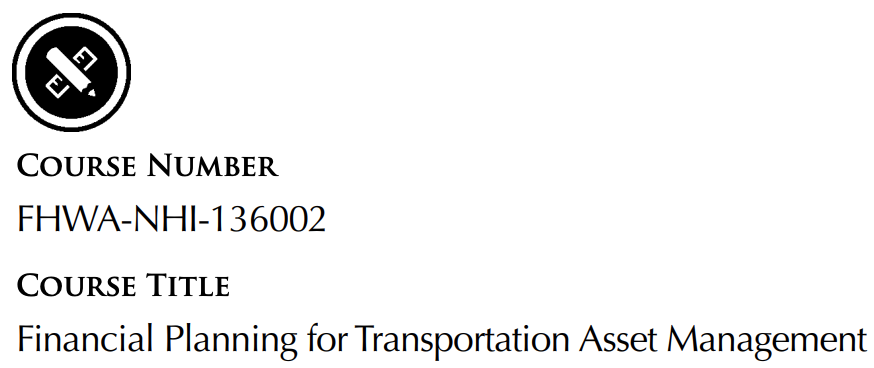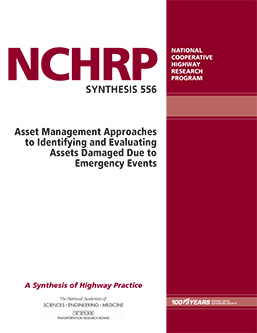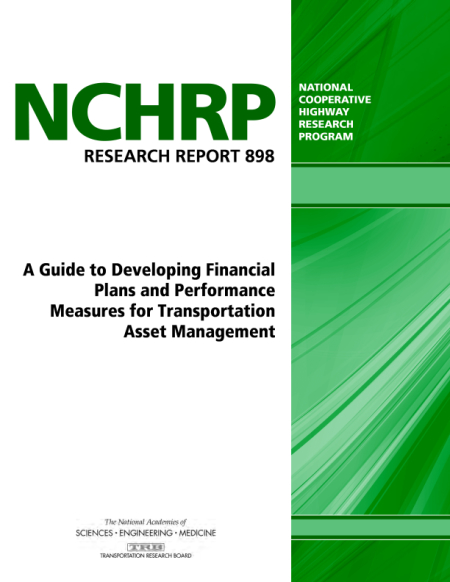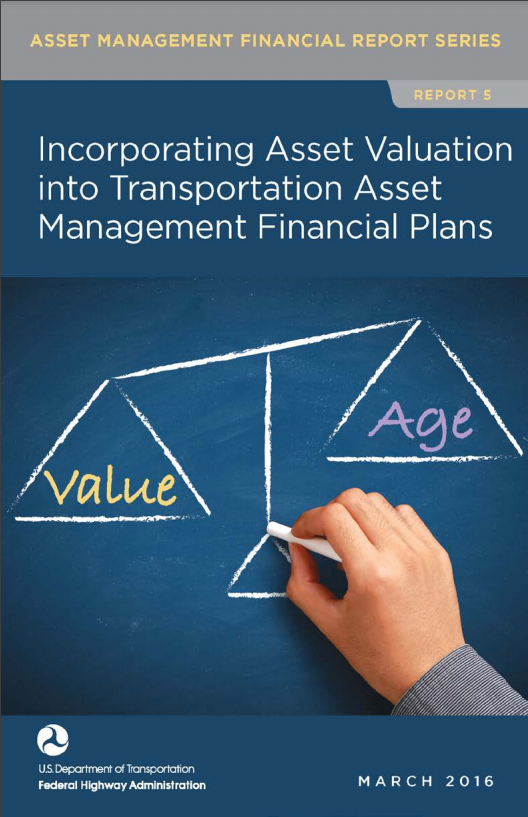Collection: TAMP Improvement
Collection: TAMP Improvement
Description
This collection contains a set of resources for TAM practitioners to use in order to improve different facets of their TAMPs. Improvement categories include: Performance Gap Analysis, Life Cycle Planning, Risk Management, Financial Planning and more. Filter the set of resources using the controls on the left of the page.
To search the resources by state either click on the state from the map or select a state from the dropdown under search filters.
Risk Management | Training
This course is targeted for employees at the Federal, State and local level who oversee any portion of their agency's highway-related programs as well as asset management practitioners. Participants will be introduced to a number of different tools, techniques, and principles that they may apply to risk management at any level across their organization. Throughout this 2-day course, participants will be taught how to use the risk management process for developing risk strategies and how to apply it in their work. The training is structured around some instructor presentation with an emphasis on group discussion and several team-based activities.
TAM Webinar 50 - Improving Your Next TAMP Miniseries: Improving Risk Management and Resiliency | VideoWebinar/Video
Asset ManagementRisk management and building resiliency is of growing importance for transportation agencies and is an integral part of an agency’s TAMP. The 2018 and 2019 TAMPs were required to be risk-based and include a risk register. In many of the initial TAMPs, agencies were early in their understanding of risk management in the context of transportation asset management (TAM). Agencies will have the opportunity to improve their risk management and resiliency elements of their next TAMPs as they have improved their understanding and practices related to TAM and risk management/resiliency. This webinar features discussion from DOTs on how they have used their initial TAMP risk registers and how they plan to enhance their risk registers and risk management and resiliency building processes in their updated TAMPs.
A video of the webinar is available here. The slides for the webinar are available here.
TAM Webinar 49 - Improving Your Next TAMP Miniseries: Improving Life Cycle Planning and Management | Video
Asset Management, System PerformanceLife cycle planning and management is a foundational component of transportation asset management. The progress that agencies are making in this area is noteworthy. Many resources are also available to help agencies with improving practices. This webinar shares an overview of the progress that agencies are making in improving life cycle planning and management practices and shares new and soon-to-be available resources.
TAM Webinar 48 - Improving Your Next TAMP Miniseries: Improving Your Financial Plan | VideoWebinar/Video
Asset Management, EconomyA financial plan is a required element of the TAMP. How well the financial plan is integrated with other elements of the TAMP can provide an indication of an agency’s TAM maturity. Financial planning advanced between the 2018 and 2019 TAMPs and more progress is anticipated in the next rounds. Resources have been developed through FHWA and TRB to support financial plans – and more resources are currently under development. This webinar shares some of the advancements in financial planning at transportation agencies and highlights new and upcoming resources to assist agencies in improving their TAM financial plans.
Transportation Asset Management Plans: Case Study 4 - Managing Risks to Assets | Case Study/Practice Example
Asset ManagementAs the fourth case study in the transportation asset management plans series, this study identifies good practices around risk management adopted by ten different state DOTs. Washington State (WSDOT), California, Kansas, South Dakota, Louisiana, Rhode Island, Pennsylvania, Texas, Colorado, and Michigan all display insightful practices related to risk management. From WSDOT's incorporation of risk management into nearly every element of their TAMP to Caltrans' partnerships with other agencies to reduce risk, this set of case studies takes a deep dive into standout practices that all state agencies could consider adopting.
Document
Feb 2021
TAM Webinar 47 - Improving Your Next TAMP Miniseries: Needs and Priorities | VideoWebinar/Video
Asset ManagementThis webinar uses an interactive format to get your input on what is most needed to improve your next TAMP. Polls assess the audience’s opinions in real-time on a variety of topics related to the next TAMP and address topics including: the areas that most need improvement, elements of the TAMP that most help agencies, areas where additional resources are most needed, and what those resources are. The polls are complemented by an interactive discussion with the facilitators and participants. A summary of the federal requirements and an overview of available resources will also be presented.
FHWA Pavement Management & Performance | Website
Asset Management, PavementThe Pavement Management & Performance program provides technical support to pavement managers, it participates in national policy discussions, and it studies emerging methods and technologies for collecting pavement data. Their homepage on FHWA's website contains a wealth of resources, including a series of quarterly pavement webinars and other publications. Explore the page for any resources that may be useful for improving pavement management.
TAM Webinar 46 - Improving Your Next TAMP Miniseries: Overview | Video
Asset ManagementThis webinar kicked-off the Improving Your Next TAMP Miniseries. The next cycle of TAMP development is around the corner and agencies need to figure out how they will develop their next TAMP. The purpose of the miniseries is to take a deeper dive into this topic of potential TAMP enhancements and help to provide knowledge, inspiration, and capacity to build a better TAMP.
This first installment focused on the findings of a recent set of FHWA TAM case studies. The case study subject—PennDOT—discussed the case study findings, reflecting on the agency’s 2019 TAMP and plans for their next TAMP.
Performance-Based Planning and Programming | Website
Asset ManagementPerformance-based planning and programming connects the day-to-day asset management decisions with a broader long-range plan, and it unites both under a common set of goals. On this FHWA webpage, you can find more information on the topic and links to performance-based planning resources.
Financial Planning for Transportation Asset Management | Training
Over the span of 1.5 days, the course, "Financial Planning for Transportation Asset Management" takes participants through all the key concepts to developing a financial plan for TAM. As part of the course, a facilitator will guide small working groups through creating a financial plan that covers each content area. Within the groups, participants will also be asked to identify events that alter change the plan's effectiveness. Lastly, participants will be led through establishing next steps for their agency to fully develop their financial plan.
training
Jun 2020
Asset Management Approaches to Identifying and Evaluating Assets Damaged Due to Emergency Events | Research Report
Asset Management, Bridge, PavementNCHRP Synthesis 556 summarizes state DOT practices used to identify pavement and bridge asset locations repeatedly damaged by emergency events and to mitigate the risk of recurring damage in those locations. The synthesis focuses particularly on mitigation practices that concurrently advance TAM and TPM objectives. Information for this synthesis was gathered through a literature review, a survey of state DOTs, and follow-up interviews with selected agencies.
Transportation Asset Management Plans: Case Study 1 - Asset Management Practices and Benefits | Case Study/Practice Example
Asset ManagementThis case study examines examples from the 2019 transportation asset management plans, highlighting how asset management provides benefits to the agency. The states included in the analysis are New Jersey, Pennsylvania, Illinois, and Washington State. Their impact includes a documentation of asset management practices and bringing about change in the agency.
Document
May 2020
Transportation Asset Management Plans: Case Study 2 - Linking Asset Management to Planning and Programming | Case Study/Practice Example
Asset ManagementIn this case study, six examples are selected from Maine, Missouri, Montana, Ohio, Utah, and Wyoming demonstrating the connection between asset management and many plans and implementations. The case studies emphasize how asset management supports long range plans, the statewide transportation improvement program, and state planning and programming practices.
Document
May 2020
Transportation Asset Management Plans: Case Study 3 - Life Cycle Planning Practices | Case Study/Practice Example
Asset ManagementThis case study highlights examples from the transportation asset management plans of Minnesota, Ohio, New Jersey, and Tennessee. The states in these cases provide excellent examples on how to manage assets through life cycle plans, and they demonstrate how life cycle planning may result in significant savings and improved conditions.
Document
May 2020
Transportation Asset Management Plans: Case Study 5 - Financial Planning and Investment Strategies | Case Study/Practice Example
Asset ManagementThis case study highlights financial planning practices undertaken by seven states in their 2019 transportation asset management plans. These states connected their asset management objectives with their funding gaps, risks, and investment strategies, and they presented a thoughtful approach for allocating scarce resources. The state agencies include: Kentucky Transportation Cabinet, Michigan DOT, Washington State DOT, New York State DOT, Utah DOT, Vermont Transportation Agency, and Illinois DOT.
Document
May 2020
Transportation Asset Management Plans: Case Study 6 - Communicating Asset Management Strategies | Case Study/Practice Example
Asset ManagementIn their 2019 transportation asset management plans, many states identified practices for connecting with internal and external partners. This case study presents examples from California, Colorado, Michigan, Nebraska, New Jersey, Ohio, Vermont, and Washington State which demonstrate how coordination with MPOs and local owners of national highways can improve the overall asset management across the state.
Document
May 2020
Transportation Asset Management Plans: Case Study 7 - Managing Assets Beyond Pavements and Bridges | Case Study/Practice Example
Asset ManagementWhile most states still focus solely on their bridge and pavement assets, a handful of states are demonstrating the benefits and best methods for including other assets in their transportation asset management plans. Among these states, California, Connecticut, Minnesota, and Utah are identified for their forward-looking practices. Highlighted in this case study, these state agencies include a whole range of non-traditional assets from signs and ITS to sidewalks and pavement markings.
Document
May 2020
FHWA Bridge Management | Website
Asset Management, BridgeOn this webpage, FHWA highlights numerous important documents relating to bridge management and provides contact information for the Office of Bridges and Structures. These documents include regulations and guidance on bridge performance measures, case studies from different states, and relevant NCHRP projects. Explore the site for more details and access to the full list of resources.
AASHTO Transportation Asset Management Guide | Guide/Manual
Asset Management, Bridge, PavementAASHTO Transportation Asset Management Guide presents a comprehensive introduction to asset management concepts and practices. The guide is intended to foster understanding of asset management techniques and advance asset management practices at transportation agencies. Read more at: https://www.tamguide.com.
Performance Management Reporting Peer Exchange Final Report – NCHRP Project 20-24 Task 124 | Research Report
Asset Management, PavementThe NCHRP 20-24 Task 124 Performance Management Reporting Peer Exchange was held on Tuesday October 16th and Wednesday October 17th, 2018 at the Hall of States in Washington D.C. Representatives from 18 state DOTS, the Federal Highway Administration (FHWA), the American Association of State Highway and Transportation Officials (AASHTO) and the Transportation Research Board (TRB) attended. Participants were subject matter experts in performance management, pavement management and communications. The goal of the Peer Exchange was to help DOTs develop a toolkit and strategies for communicating the difference between state and Federal pavement performance in a consistent narrative. While this Peer Exchange focused on pavement performance, the process can be used as a framework to develop strategies to help states communicate other performance measures. A toolkit and summary are available in addition to the final report.
Handbook for Including Ancillary Assets in Transportation Asset Management Programs | Guide/Manual
Asset ManagementThis handbook presents a methodology that will aid highway asset owners and maintenance personnel with determining what assets, beyond pavements and bridges, are most important to support their agencies’ missions and goals. The methodology prioritizes asset classes and identifies data related to those assets that best support a performance-based approach to managing the condition and utilization of those assets. The methodology is comprehensive, yet flexible, so it may be tailored to each agency’s specific needs.
A Guide to Developing Financial Plans and Performance Measures for Transportation Asset Management (NCHRP Report 898) | Research Report
Asset ManagementThis report presents guidance for state departments of transportation (DOTs) and other agencies conducting financial analyses and developing financial plans to support efficient and effective management of the agency’s transportation assets.
Management and Use of Data for Transportation Performance Management: Guide for Practitioners | Research Report
System PerformanceThis report provides practical guidance to transportation agencies to help improve their use of data for performance management. Recent federal legislation has highlighted the importance of data utilization in performance management. The guidance focuses on six areas of the data life-cycle allowing for analysis on decisions and to identify opportunities for improvement. The purpose of this report is to allow for agencies to enhance their insight into their performance and to boost results.
Using an LCP (Life Cycle Planning) Process to Support Transportation Asset Management: A Handbook on Putting the Federal Guidance into Practice | Guide/Manual
Asset Management, Bridge, PavementThis handbook provides guidance to state DOTs and other agencies applying (or seeking to apply) life-cycle planning (LCP) to their investment decisions. Tailored toward bridge and pavement, the handbook centers around using asset management systems to support TAMP development. It describes in technical terms the nature of the relationship between target setting, performance gap analysis, and performance model development on LCP and vis versa.
Guidelines for Development and Approval of State Data Quality Management Programs | Guide/Manual
Asset Management, Bridge, PavementThe National Performance Management Measures to Assess Pavement Condition (PM2) requires states develop Data Quality Management Programs (DQMPs) to improve their pavement condition metrics. This guidance explains FHWA's approval process for states' DQMPs including the evaluation criteria for different elements of the plan and examples of good practice at each step. In the appendix, there is also a template for the DQMP.
FHWA Computation Procedure for the Bridge Condition Measures | Guide/Manual
Asset Management, BridgeThis document provides transparency to to the public and aids state DOTs in computing bridge condition measures. It outlines the calculation steps for determining the minimum bridge condition levels by state and the DOT's progress towards their targets.
FHWA Computation Procedure for the Pavement Condition Measures | Guide/Manual
Asset Management, PavementThis document provides transparency to to the public and aids state DOTs in computing pavement condition measures. It outlines the calculation steps for determining the minimum pavement condition levels by state and the DOT's progress towards their targets.
Interstate Highway Pavement Sampling Quality Management Plan | Guide/Manual
Asset Management, PavementThis document details the Quality Management Plan (QPM) for an FHWA study collecting and analyzing 7500 miles of pavement condition data on the Interstate System. The project seeks to understand and verify the data stored in the Highway Performance Monitoring System (HPMS) by checking it with a national baseline, and this plan intends to control the quality of the project's data collection. This QMP outlines the standards and protocols for their data deliverables, explains how manual raters are certified, describes equipment calibration, certification, and verification, reports on the data quality checks, and finishes with a review of the data deliverables.
Developing TAMP Financial Plans: Final Guidance | Guide/Manual
Asset Management, Bridge, PavementThis document explains how State DOTs can develop financial planning processes to support development of their 10-year transportation asset management plans (TAMPs). The FHWA defines a TAMP financial plan as “a long- term plan spanning 10 years or longer, presenting a State DOT’s estimates of projected available financial resources and predicted expenditures in major asset categories that can be used to achieve State DOT targets for asset condition during the plan period, and highlighting how resources are expected to be allocated based on asset strategies, needs, shortfalls, and agency policies.”1 The TAMP financial plan describes the financial environment in which the agency expects to operate on an annual basis over the full time period covered by the TAMP.
Incorporating Risk Management into Transportation Asset Management Plans: FHWA Interim Guidance | Guide/Manual
Asset Management, Bridge, PavementThis document provides guidance on the risk element of a risk-based transportation asset management plan (TAMP), defines risk, and provides guidance on how the risk element can be applied to meet the requirements of a risk-based TAMP.
Using a Life Cycle Planning Process to Support Asset Management: Final Guidance | Guide/Manual
Asset Management, Bridge, PavementThis document provides guidance on developing an initial lifecycle planning (LCP) process that satisfies the requirements in the Asset Management Rule and leads to the identification of an effective investment strategy for managing transportation assets. As agencies mature in their use of an LCP process it is
anticipated that they will be able to employ more sophisticated analysis tools and techniques.
AASHTO Guide for Enterprise Risk Management | Guide/Manual, Research Report
This guide provides a comprehensive framework to identify and manage risk for state departments of transportation, as well as establish and maintain an enterprise risk management program. It includes extensive summaries of how risk management is being applied nationally and internationally to typical transportation program areas.
Incorporating Asset Valuation into Transportation Asset Management Financial Plans | Guide/Manual
Asset ManagementThe final report in the Asset Management Financial Report Series covers asset valuation and depreciation for TAM. Asset value is commonly used in the UK and Australia to capture and convey meaning from asset condition and age. It demonstrates the benefit an asset brings to society, while depreciation acknowledges the costs. Through this report, asset value is explained and its potential uses are displayed; examples are provided from states with exemplary practices and other potential uses are offered.
Financial Planning for Transportation Asset Management: Components of a Financial Plan | Research Report
Asset Management, Bridge, PavementThis report, produced as the second installment in the FHWA Asset Management Financial Report Series, provides an overview of financial planning in the context of TAM. This report focuses on the major components of a financial plan, and describes their roles in the development of a financially conscious agency.
Financial Planning for Transportation Asset Management: An Overview | Research Report
Asset Management, Bridge, PavementThis report, produced as the first installment in the FHWA Asset Management Financial Report Series, provides an overview of financial planning in the context of TAM. The report makes a case for financial planning and covers best practices for developing a financial plan capable of cost effectively addressing agency needs and risks.
Practical Guide for Quality Management of Pavement Condition Data Collection | Research Report
Asset Management, Pavement"An effective pavement management system depends on reliable, accurate, and complete information. Having quality pavement management data is directly linked to the ability of the pavement management system to contribute to the development of reasonable and reliable recommendations and decisions regarding an agency’s pavement network. Pavement condition data are one of the key components of a pavement management system. Pavement condition data are used to model pavement performance, to trigger various actions ranging from maintenance to rehabilitation to reconstruction, to evaluate program effectiveness, and to satisfy many other purposes. While there are many different methodologies used for assessing pavement condition, ranging from manual surveys to fully automated procedures, the need for quality data remains the same. Agencies take a number of steps to ensure and verify data quality, including calibration of the data collection equipment or the inspection teams, incorporating quality control sections that are reinspected to assess repeatability, and verifying reasonableness and completeness of the pavement condition survey. The ability to evaluate and determine the quality of pavement condition data is essential for establishing the accuracy and reliability of analyses made using pavement condition. The Federal Highway Administration (FHWA) sponsored the development of a Practical Guide on Quality Management Procedures for network-level pavement condition data. The Practical Guide provides information related to the development and implementation of a QM program, incorporating proven QM practices, and showcasing examples or case studies using pavement condition data from a variety of state DOTs."
Quality Management of Pavement Condition Data Collection (NCHRP Synthesis 401) | Research Report
Asset Management, PavementTransportation agencies are developing procedures and guidelines for managing the quality of pavement data collected to ensure the data meet the needs of the pavement management process. This study reviews the quality management practices being employed by public highway agencies for automated, semi-automated, and manual pavement data collection and delivery. Information was gathered through literature review, surveys of U.S. state and Canadian province public agencies and private contractors, and selected interviews.
Document
Jan 2009
Effective Methods for Setting Transportation Performance Targets (NCHRP 23-07) | Research Report
Asset Management, Economy, Environment, Safety, System PerformanceThis research will culminate in a TPM target setting guidebook for state DOTs. The guide will cover methods for target setting, both qualitative and quantitative data sources, and how to adjust targets for different challenges. This NCHRP Project is not scheduled for completion until September 2022.




